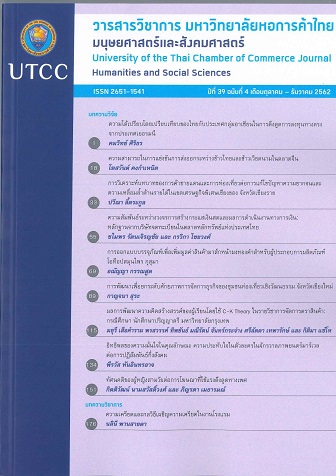The Outcome of Student Creativity Development with C-K Theory in Brand Management Course: A Case Study of Bachelor’s Degree Students at Bangkok University
Main Article Content
Abstract
This research focused on creative development by having two objectives: 1) to compare the students’ creativity, creative role identity as well as their creative self-efficacy before and after using C-K theory and, 2) to study the students’ creative role identity and creative self-efficacy influencing their creativity. Quasi experimental research design through one group pretest posttest design was employed as the research methodology. The research population consisted of 628 bachelor’s degree students, who registered for Brand Management Course at Bangkok University in semester 2/2018. With cluster section sampling, 53 students were selected, who have completely data. The research instrument consisted of a 4-item test for creative role identity, a 6-item test for creative self-efficacy and a Torrance’s creative test with 4 dimensions (fluency, originality, flexibility and elaboration). The statistics used for data analysis were descriptive statistics, dependent t-test, gain score analysis, and multiple regressions. The findings revealed that originality and creative self-efficacy increased after doing the activity based on C-K theory; moreover, creative role identity influenced creativity development.
Article Details
ลิขสิทธิ์ของบทความ
ผลงานที่ได้รับการตีพิมพ์ถือเป็นลิขสิทธิ์ของมหาวิทยาลัยหอการค้าไทย ห้ามมิให้นำเนื้อหา ทัศนะ หรือข้อคิดเห็นใด ๆ ของผลงานไปทำซ้ำ ดัดแปลง หรือเผยแพร่ ไม่ว่าทั้งหมดหรือบางส่วนโดยไม่ได้รับอนุญาตเป็นลายลักษณ์อักษรจากมหาวิทยาลัยหอการค้าไทยก่อน
References
ศิริชัย กาญจนวาสี. (2556). ทฤษฎีการทดสอบแบบดั้งเดิม. กรุงเทพฯ: จุฬาลงกรณ์มหาวิทยาลัย.
Barbot, B., Lubart, T. I., & Besançon, M. (2016). “Peaks, Slumps, and Bumps”: Individual differences in the development of creativity in children and adolescents. New Directions for Child and Adolescent Development, 2016(151), 33-45.
Cole, D. G., Sugioka, H. L., & YAMAGATA‐LYNCH, L. C. (1999). Supportive classroom environments for creativity in higher education. The Journal of Creative Behavior, 33(4), 277-293.
De Stobbeleir, K.M., Ashford, S.J., & Buyens, D. (2011). Self-regulation of creativity at work: The role of feedback seeking behavior in creative performance. Academy of Management Journal, 54(4), 811-32.
Farmer, S. M., & Tierney, P. (2017). Considering creative self-efficacy: Its current state and ideas for future inquiry. In M. Karwowski, & J. C. Kaufman (Eds.), The creative self: How our beliefs, self-efficacy, mindset, and identity impact our creativity (pp. 23-47). San Diego: Academic Press.
Farmer, S.M., Tierney, P., & Kung-McIntyre, K. (2003). Employee creativity in Taiwan: An application of role identity theory. Academy of Management Journal, 46(5), 618-30.
Gardner, H. (1993). Creating minds. New York, NY: Basic Books.
Grube, J., & Piliavin, J. (2000). Role identity, organizational experiences, and volunteer performance. Personality and Social Psychology Bulletin, 26: 1108 – 1119.
Hair, J. F., Black, B., Babin, B., Anderson, R. E., & Tatham, R.L. (2006). Multivariate data analysis (6 th ed.). Upper Saddle River, NJ: Pearson.
Hatchuel, A., Le Masson, P., & Weil, B. (2003). C-K Theory in practice: lessons from industrial applications. 8th International design conference, Dubrovnik. University of Zagreb.
Hatchuel, A., Le Masson, P., Weil, B., Agogué, M., Kazakçi, A., & Hooge, S. (2016). Multiple forms of applications and impacts of a design theory: 10 years of industrial applications of CK theory. In A. Chakrabarti, & U. Lindemann (Eds.), Impact of Design Research on Industrial Practice (pp. 189-208). New York: Springer International Publishing.
Holder, A., & Lovett, G. (2012). Learning from design creativity; Translating processes from practice to education. In A. Duffy, Y. Nagai, & T Taura (Eds). The 2nd International Conference on Design Creativity Volume 2 (pp. 92-98). Glasgow, Scotland.
Jaussi, K. S., Randel, A. E., & Dionne, S. D. (2007). I am, I think I can, and I do: The role of personal identity, self-efficacy, and cross-application of experiences in creativity at work. Creativity Research Journal, 19(2-3), 247-258.
Karwowski, M., Lebuda, I., Wisniewska, E., & Gralewski, J. (2013). Big five personality traits as the predictors of creative self‐efficacy and creative personal identity: Does gender matter?. The Journal of Creative Behavior, 47(3), 215-232.
Loudon, G., & Deininger, G. (2014). A new model for supporting creativity in research organisations. Proceedings of the R&D Management Conference. Fraunhofer IAO, IAT Universität Stuttgart.
McCall, G., & Simmons, J.L. (1978). Identities and interaction. New York: Free Press.
Oldham, G.R. & Cummings, A. (1996). Employee creativity: Personal and contextual factors at work. Academy of Management Journal, 39(3), 607-634.
Reich, Y., Hatchuel, A., Shai, O., & Subrahmanian, E. (2012). A theoretical analysis of creativity methods in engineering design: casting and improving ASIT within C–K theory. Journal of Engineering Design, 23(2), 137-158.
Shibuya,T., Seshimo,S., Harashima, Y., Kubota T., & Iba, T. (2013). Educational Patterns for Generative Participants: Designing for Creative Learning. In C. K. HAN (Chair). PLoP '13 Proceedings of the 20th Conference on Pattern Languages of Programs, Monticello, IL.
Sternberg, R. J. (2006). The nature of creativity. Creativity Research Journal, 18(1), 87-98.
Torrance, E. P. (1974). The torrance tests of creative thinking-norms-technical manual research edition-verbal tests, forms A and B- figural tests, forms A and B. Princeton, NJ: Personnel Press.
Torrance, E. P. (2008). Thinking creativity with words, forms A and B. Bensenville, IL: Scholastic Testing Service.
VandenBos, G.R. (2007). APA Dictionary of Psychology. Washington, DC: American Psychological Association,


